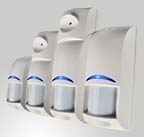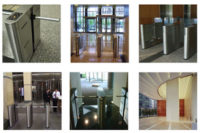“We put three to five motion detectors on every job, and we’ve been using the same type for several years,†says John Evans, president of Able Security Systems, Milwaukee, who says he rarely encounters a job that requires anything special or that cannot be served by his existing models.
Although the price of motion detectors has decreased over time, it has not caused Able Security to use any more of them on a job. “It is better if you are beefing up the system to add perimeter protection because that adds to the safety of the family at night when the alarm is on, since motions should not be used when the home is occupied,†Evans maintains.
Able uses glass-breakage sensors on approximately one-third of its jobs when customers can afford them and the perimeter absolutely must be protected, such as at a jewelry store.
Rowland Ploenzke, alarm operations supervisor for Custom Alarm, Rochester, Minn., has a rule-of-thumb for installing sensors. For residential jobs with interior detection, the company generally installs one motion detector per floor.
“We try to cover as much as we can with one motion per floor and two if need be, but we try to keep it to a minimum,†he explains. “Motion detectors tend to need more upkeep, and in our experience have the tendency to cause the most nuisance alarms.â€
For that reason, his company has been installing more pet-immune motion detectors. “More customers seem to have pets roam freely in the house,†he notes.
Rather than being lulled into a sense of complacency, however, sensor manufacturers continue to make advances in their products in an effort to make them more versatile.

Motion detectors
Several manufacturers have refined the ability of their motion detectors to better distinguish pets from human intruders.Optex USA Inc., Torrance, Calif., for example, has broken the Fresnel lens on its passive infrared detectors (PIRs) into smaller, vertically oriented zones and adjusted the sensitivity of the unit so at least three zones must see a temperature change and movement before an alarm is signaled.
“A human target will trip at least three zones, but an animal will not,†explains Optex president Rob Blair. “We tested it with short-haired dogs, long-haired dogs, big dogs and little dogs.â€
Napco Security Group, Amityville, N.Y., uses what it calls adaptive technology in its dual-technology microwave/PIR detectors to help provide immunity from pets and other installation hazards.
“It includes algorithms for analyzing signatures of false and valid alarm sources, when each is defined by size/amplitude or sequence,†relates Judy Jones, Napco’s director of marketing. “This enables the adaptive sensor to precisely assess a signal from a target and instantaneously determine if it is a human, an animal, a heater or a blowing blind.â€
Additionally, Bosch Security Systems, Fairport, N.Y., has introduced a new blue line of sensors – including a PIR, a pet-friendly PIR, a quad PIR, and a TriTech PIR/microwave – that include distinctive blue LEDs that coordinate with the blue LEDs on Bosch keypads. This gives all the products a unique family look.

Photoelectric beams
Despite the versatility of passive infrared detectors, some manufacturers say they still are not appropriate for all applications. That’s why, for example, Seco-Larm U.S.A. Inc., Irvine, Calif., has developed a new Enforcer curtain sensor photoelectric beam that targets applications where the company says PIRs will not fit, such as inside a window or door frame or on skylights.Traditional photoelectric beams have one or two beams, says Seco-Larm research and development engineer Lawrence Hwang. However, a new model from the company has four beams in its 22-inch wide configuration or six beams in its 44-inch configuration. The additional beams provide a wider coverage area that intruders cannot get around, Hwang maintains. “You could do the same thing with multiple devices, but this is all-in-one enclosure,†he points out.
Optex also is working on enhancing its photoelectric beams with digital packet communication. This is designed to help eliminate problems with cross-talk that can occur when multiple beams are installed in close proximity to each other.
“Each beam uses a 25-bit code to distinguish it from any other device,†Blair explains. “Once the receiver is powered up and synchs with the transmitter, it ignores signals from other devices.â€
Glass-breakage sensors
Although many alarm dealers use glass-breakage detectors for only a portion of their installations, at least one manufacturer hopes to expand their usage.“Five years ago, glass breaks worked if they were installed properly, but many installers considered them a pain in the neck,†asserts John Kovach, director of marketing for Honeywell Security and CE, Syosset, N.Y.
Honeywell’s new FlexGuard glass-breakage sensors eliminate the restrictions that previously existed for these products, Kovach claims, insisting that these sensors “can and should be used on every job.â€
The technology behind this, which is now available on the entire line of FlexGuard glass-breakage sensors, uses ASIC-based algorithms to help distinguish true false alarm events. This adds an extra level of sophistication not provided by earlier models that used analog pass band filters, Kovach maintains.
Wireless
As manufacturers strive to make their sensors even more sophisticated, another option may be to introduce two-way communication capability. That is an approach that Inovonics Wireless Corp., Louisville, Colo., plans to bring to its wireless sensors.The company sees a number of advantages to adding the ability for sensors to communicate more information to the alarm system other than alarms.
For example, Inovonics product manager Steve Pearlman points out that a two-way PIR could be set up so that it would not transmit alarm information unless it was armed, which would conserve battery life. Another option would be for a glass-breakage sensor to make changes in its sensitivity based on time of day.
“Within the next year or so, we will be doing some of these things,†Pearlman hints.
Sidebar
Special Situations Require Creativity
Designing an installation of effective motion detection can sometimes be cut-and-dry, and other times require extra creativity.For example, Key-Rite Security, Denver, uses passive infrared detectors primarily in access control systems to release doors when authorized people exit a business customer location. The greatest challenge installers encounter is to make sure the PIR is not too sensitive, says Key-Rite president Larry Weber. The door should not release every time someone walks in the room, but only when someone exits. To address this, the company uses PIRs with optics that can be aimed so that they only see the area directly below them.
Although motion detectors do not cause as many nuisance alarms as they used to, problems sometimes still occur. Custom Alarm, Rochester, Minn., recently devised a creative solution to a problem in a warehouse where it had installed a dual-technology device to cover a bank of overhead doors.
“Within a couple of days the customer started having false alarms, and we found out that a red-tail hawk was making the warehouse its home,†marvels Rowland Ploenzke, Custom Alarm operations supervisor.
“We decided to install an identical motion six inches below the original one and parallel the alarm circuit between the two, so the hawk would have to trip both at the same time,†Ploenzke explains.
Installers also walk-tested the new set-up to make sure that a human would trip it. “To this day, the customer has had no more nuisance alarms,†Ploenzke testifies.
Evans of Able Security suggests using a minimum of two PIRs in a business, even a small one. “One PIR could be blocked by store remodeling, signs or stacked inventory,†he points out.

